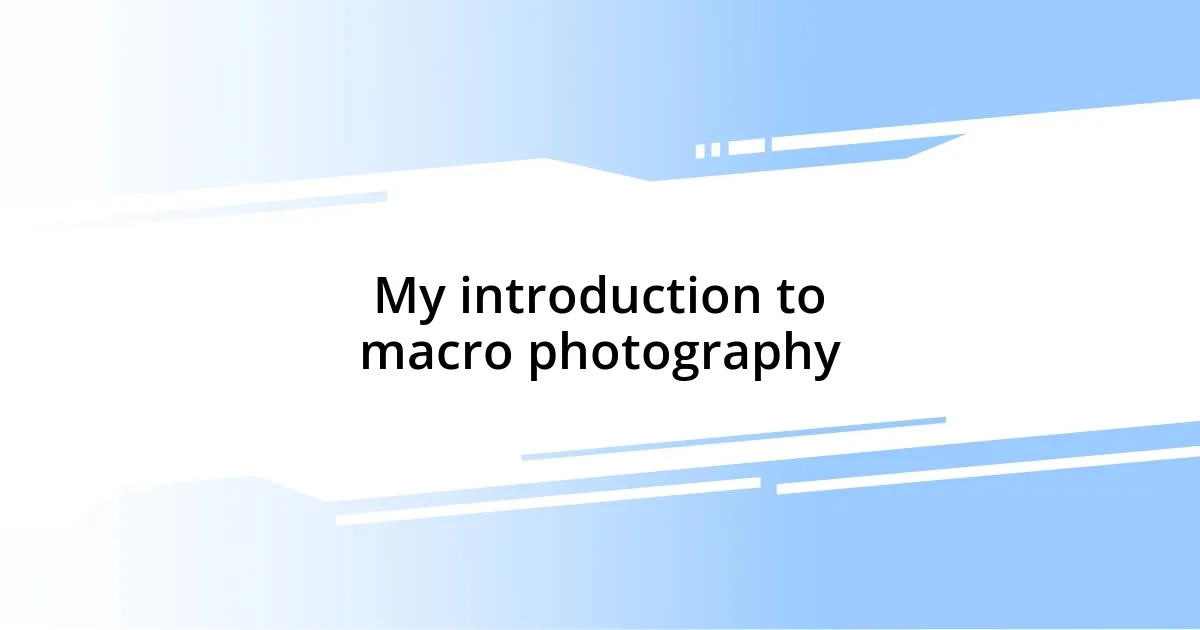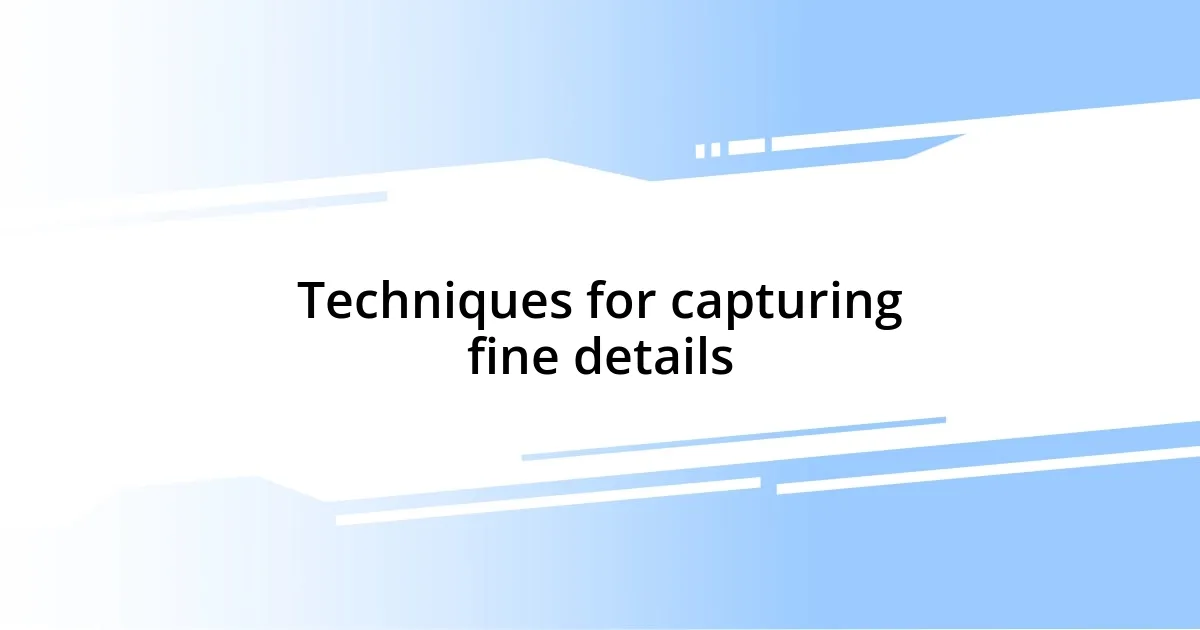Key takeaways:
- Macro photography reveals intricate details of nature, transforming ordinary subjects into captivating images.
- Essential equipment such as macro lenses and proper lighting tools significantly enhance the photography experience.
- Mastering techniques like focus stacking and thoughtful composition is vital for capturing fine details effectively.
- Sharing macro work on social media fosters community engagement and personal growth as a photographer.

My introduction to macro photography
I remember the first time I spotted a tiny dew drop resting on a flower petal. I felt a rush of excitement; it was almost like discovering a hidden world right in my backyard. I couldn’t help but wonder, how many more miniature wonders were waiting to be captured?
As I delved deeper into macro photography, each click of the shutter felt like unraveling a secret. I found myself mesmerized by the intricate details of insects and flowers, something I had never really noticed before. I’d often ask myself, “What stories do these small subjects hold that remain unseen to the casual observer?”
During those early days, I faced challenges, like finding the right lighting to bring out the beauty in subjects so tiny. But overcoming those hurdles made each successful shot even more rewarding. The emotion I felt when I finally captured a stunning image reminded me of why I had fallen in love with photography in the first place—it’s about connecting with the world in a more profound way.

Essential equipment for macro photography
When I started capturing the minute details of flowers and insects, the right equipment played a crucial role. I quickly realized that while talent and a good eye are important, having the right tools can make all the difference. I often started my sessions excited but slightly overwhelmed by the options available. Over time, though, I pinpointed what I truly needed for my macro adventures.
Here’s a list of essential equipment that I found indispensable in my macro photography journey:
- Macro Lens: A dedicated macro lens allows you to focus on tiny subjects and capture exquisite details.
- Tripod: Stability is key, especially when working with extreme close-ups where even the slightest movement can blur your shot.
- Ring Light or External Flash: Proper lighting enhances the clarity and richness of colors in your images, revealing details that natural light might miss.
- Extension Tubes: These versatile attachments can expand the focusing distance of your lens, allowing for even closer views of your subject.
- Reflector: A simple reflector helps bounce light onto your subject, making it pop without harsh shadows.
- Remote Shutter Release: Reducing camera shake is critical in macro photography, and using a remote helps in achieving sharper images.
Investing in these tools not only enhances the quality of your images but also enriches the overall experience of exploring the intricate details of nature. I still remember the day I got my first macro lens; it felt like unlocking a new level in my photography journey. Each session became a treasure hunt, and those tools helped me reveal stories hidden in plain sight.

Techniques for capturing fine details
Capturing fine details in macro photography requires a keen eye and some specific techniques that I’ve picked up along the way. One technique that proved invaluable was mastering focus stacking. I often found that even with the best macro lens, the depth of field could be frustratingly shallow. By taking multiple shots at different focus points and merging them in post-processing, I could create images with stunning clarity from front to back. It’s a bit like threading a needle; it takes a soft touch and patience.
Lighting is another factor that can dramatically change the outcome of a macro image. I remember one time, eager to photograph a butterfly resting on a flower, I struggled with harsh sunlight that caused unflattering shadows. Eventually, I learned to use a diffuser to soften the light, which not only enhanced the details of the butterfly’s wings but also added a magical glow to the scene. It’s amazing how changing the light can transform an image from average to breathtaking.
Finally, composition plays a crucial role in emphasizing the fine details I wish to capture. Initially, I would just zoom in and shoot what caught my eye. Over time, I learned to consider elements like leading lines and negative space to guide the viewer’s attention to the intricate details I wanted to showcase. I recall a moment capturing the delicate veins on a leaf; framing it just right allowed the viewer to appreciate not only the detail but the beauty of nature’s design. These techniques have enhanced my macro photography journey significantly, bringing me closer to the small wonders that surround us.
| Technique | Description |
|---|---|
| Focus Stacking | Combining multiple images at different focus points for greater depth of field. |
| Lighting Control | Using diffusers or reflectors to soften and manipulate light for better detail. |
| Thoughtful Composition | Considering elements like leading lines and negative space to enhance focus on details. |

Understanding lighting in macro photography
Understanding lighting in macro photography can truly feel like an art form. I vividly remember one afternoon while photographing dew-kissed spider webs. I was eager to capture the glistening drops but found myself battling the harsh midday sun. It was a lesson learned; soft, diffused light brings out the intricate details without overwhelming the subject. Have you ever taken a shot only to realize later that the lighting completely altered the mood of your image?
Natural light can be both a friend and a foe. I often experiment with the golden hour; there’s something magical about the warm, natural glow that enhances the colors of flowers or the delicate features of insects. On one memorable evening, I chased the light as it began to dip below the horizon, revealing vibrant hues in a butterfly’s wings that I’d never noticed before. It made me wonder: how much beauty have I overlooked simply because of poor lighting choices?
Yet, using artificial lighting tools like ring lights or reflectors can transform an ordinary scene into a captivating image. I fondly recall a time I placed a reflector just right to illuminate the tiny hairs on a bumblebee. Suddenly, the photograph had depth and dimension, pulling me and anyone who viewed it into the minutiae that often goes unnoticed. Isn’t it exhilarating how a simple adjustment can unveil layers of detail and emotion in your work?

Common challenges in macro photography
One of the most common challenges I faced in macro photography was dealing with camera shake. Even the slightest movement can blur your beautifully composed shots. I recall a frustrating day trying to capture a ladybug on a stalk of grass. I was so focused on the tiny details that I forgot the importance of stabilizing my camera, and every attempt ended up blurry. It was a turning point for me; I invested in a sturdy tripod, which made a world of difference. Have you ever felt that thrill of finally nailing a shot you previously thought impossible?
Focusing on such small subjects can also be perplexing. I remember trying to photograph a drop of water clinging to a leaf only to find my autofocus system couldn’t lock onto it. The solution for me was manual focusing. It requires patience and a steady hand, but I learned to appreciate the creative control it offers. Each delicate adjustment can feel like a small victory. Isn’t it amazing how mastering a simple skill can unlock a new level in your photography journey?
Then there’s the challenge of capturing the right moment. In macro photography, timing is everything. I was once crouched for what felt like ages, waiting for a bee to grace my frame, only to miss it as it zipped away. It taught me the value of being prepared at all times and having quick access to my camera settings. I started carrying my gear ready to shoot, always alert to that perfect moment. How many magical details have you missed simply due to not being ready?

Editing tips for macro images
When it comes to editing macro images, I’ve discovered that subtle adjustments can lead to breathtaking results. One time, while working on a close-up of a butterfly wing, I noticed the colors just didn’t pop. A little boost in saturation and contrast transformed the muted tones into vibrant hues, making the intricate patterns truly stand out. Have you ever looked back at an edited image and realized just how much a slight change can elevate a photograph?
I often use cropping to refine the composition of my macro shots. I remember snapping a picture of a bee, but the background was cluttered and distracting. By cropping tightly around the bee, not only did I highlight its beauty but also brought focus to the action of pollination. This really makes me wonder: how much do we overlook in our compositions that could be ‘fixed’ with a few clicks?
Lastly, applying sharpening techniques is a critical step in editing macro images. I’ve faced moments where an image looked great but lacked that crispness, especially when capturing tiny subjects like insects. After a gentle sharpening, I realized that it not only brought attention to those minute details but also created a sense of depth that was missing before. It’s fascinating how enhancing an image’s sharpness can transform it, pulling the viewer right into the scene. Have you experimented with sharpening? What changes have you noticed?

Sharing and showcasing macro work
Sharing my macro work has become a rewarding part of my photography journey. I remember when I first posted an image of a dew-kissed spider web online. The response was overwhelmingly positive, and it ignited a fire in me to share more. Every like and comment felt like a nudge to explore deeper into the tiny worlds around us. Have you ever felt that sense of validation when others appreciate your work?
For me, social media platforms have been a fantastic avenue for showcasing my macro photography. I often explore dedicated groups where enthusiasts share tips and critique each other’s work. One post I shared featuring a close-up of a dragonfly’s eye sparked an inspiring conversation about techniques and gear. It’s incredible how community engagement can push your creativity and help you learn from fellow photographers. Have you connected with others who share your passion?
I’ve also started participating in online photography challenges that focus on macro themes. One challenge required us to capture the essence of spring through close-ups. It motivated me to experiment with lighting and angles, ultimately leading to my proudest shot of a blossoming flower. It made me realize that sharing isn’t just about showcasing; it’s also about growth and collaboration. What have you discovered about your own photography when you stepped outside your comfort zone?












